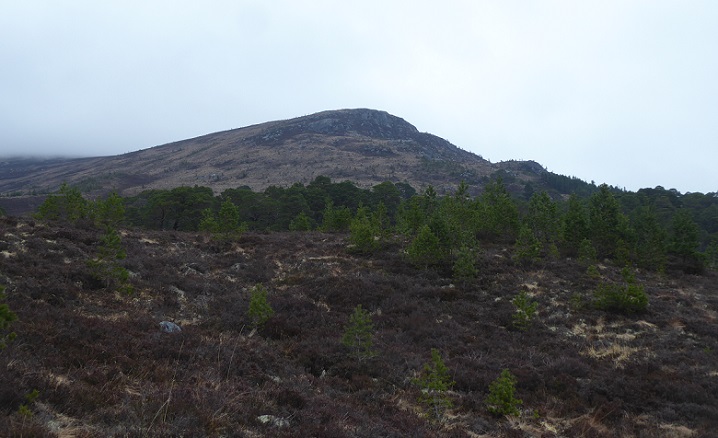
In 1995 the Mar Lodge Estate was bought by the National Trust for Scotland with a £10m+ grant from the Heritage Lottery Fun and a £4.5m grant from the Easter Trust. In 1996 NTS agreed with Scottish Natural Heritage (SNH) set of principles by which the estate should be managed including that the remnants of Caledonian Forest in glen Quoich, Derry and Lui be enabled to expand and become “self sustaining” through natural regeneration:

Note how back in 1996 SNH set a benchmark deer density for pinewood regeneration of three deer per square km. That is seven deer per sq kilometre less than 10 they have set for the equally, if not more sensitive, habitats at Caenlochan as I explained in my first post in this series on deer density (see here).
Seven years after the purchase of Mar Lodge I was appointed to the Board of Scottish Natural Heritage, now re-branded NatureScot. During my three years on the board there was a two day meeting in Ballater which included a visit to the Mar Lodge Estate to look at how the natural regeneration was faring there.
I remember the visit well, we started up the ridge in the photo – we did not get very far as some of the board were not very fit – and saw more or less nothing, a hillside bereft of trees although a member of staff did point out some star sedge. I was left wondering what it was all about but did not have enough ecological expertise to ask the right questions or to look out for signs of deer grazing.
I don’t recall any other board member knowing the right questions to ask either. We were left with the impression that natural regeneration was a painfully slow process. While I do not recall it being stated explicitly, the logical conclusion to this line of thinking was that to save Scotland’s Caledonian pine forest remnants it would be necessary to plant, plant, plant.
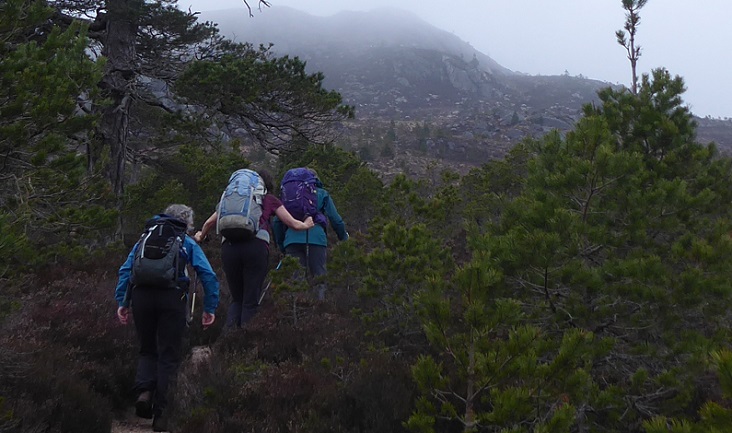
Twenty years later the experience of starting up that hillside is totally different and reminiscent of walking through krumholz pine in the Alps, with lots of trees around waist to chest height. It is too low, of course, to be real krumholz, since the pine at this altitude are not stunted, just young. The way the pine are spreading up the hill, however, means that one can predict with confidence that proper stunted pine and other montane scrub will develop in due course.
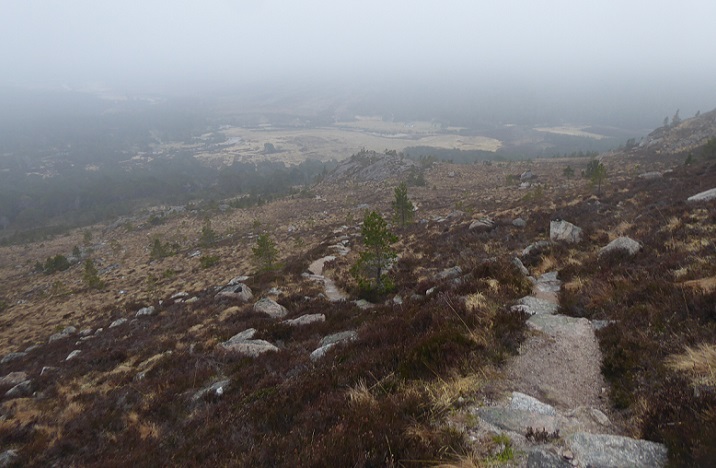
Ten years after I had left the SNH Board, I finally began to understand why we had seen so little natural regeneration on that site visit. The issues are well described by Shaila Rao, the Mar Lodge ecologist, in an article she wrote in 2017 (see here) and are encapsulated in her bar chart showing deer density in the regeneration zone:
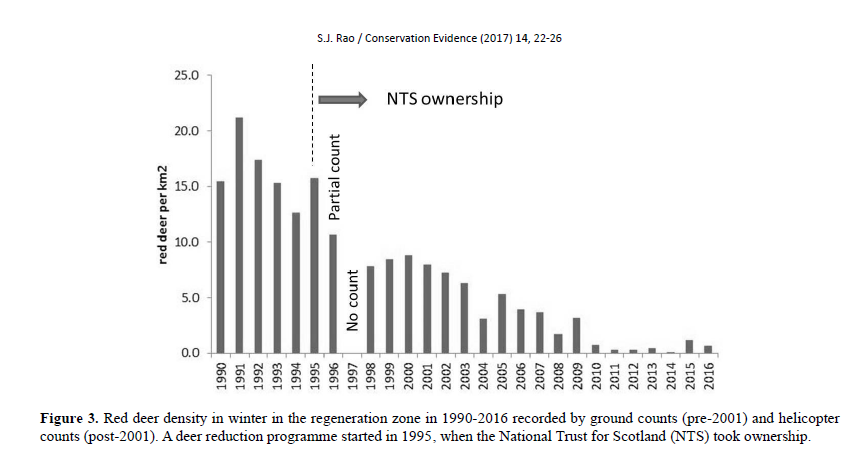
At the time of the SNH visit deer density in the regeneration area on Mar Lodge was still significantly higher than three per square kilometre, hence why we saw so little. As the article explains that was partly due to undercounting but it was also I think a result of reluctance by estate staff at the time to reduce deer numbers as is evidenced by their still being fed, rather than shot, in winter. But the figure for deer density of three per square km, although progressive at the time, was still slightly too high.
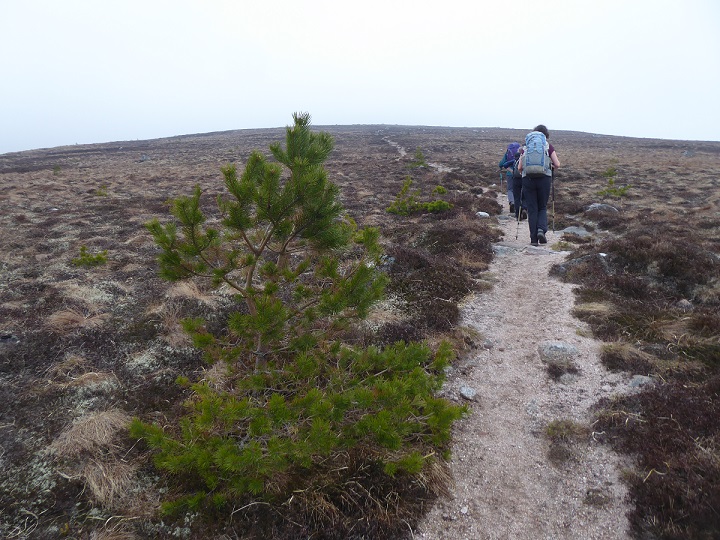
Natural regeneration only really took off when deer density fell consistently below 2 per square km from 2010 onwards. You can actually see this walking up the hill. Conifers commonly produce a whirl of new branches a year which makes it possible to estimate the age of young (ungrazed) trees. Once we were off the lowest ground, the oldest trees we saw were about 12 years old.
Scots Pine generally start to produce seed when they are 15-20 years old. Within the next decade therefore the number of trees producing seed is going to increase considerably and that should increase the rate of natural regeneration still further.
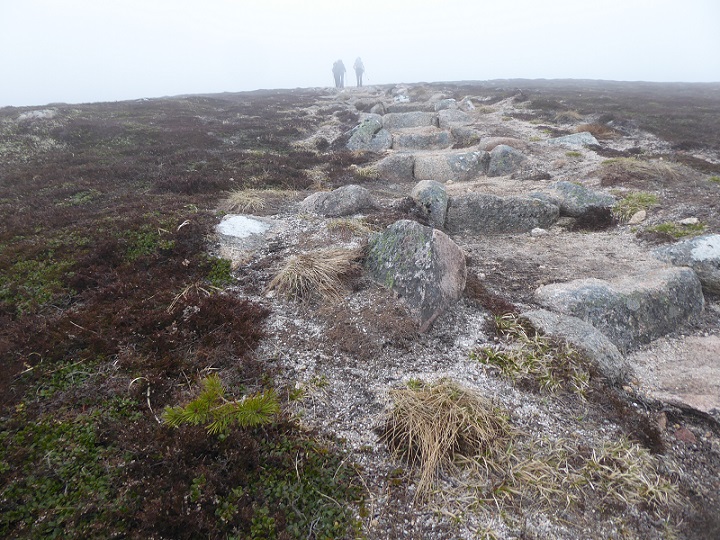
Walking up the path to Derry Cairngorm there was plenty of evidence to show that proximity to seed source and deer density are not the only factors affecting natural regeneration and that wind, soil, other vegetational ground cover and grazing all play a role. While wind distributes pine seed, it can also make it very difficult for it to get established in places.
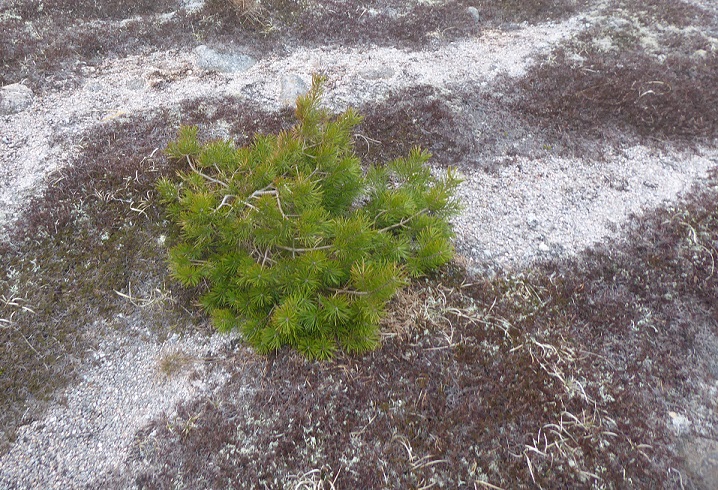
In areas with granitic gravelly soils like this, where a seed lodges in the gravel and then germinates it has almost no chance of survival.
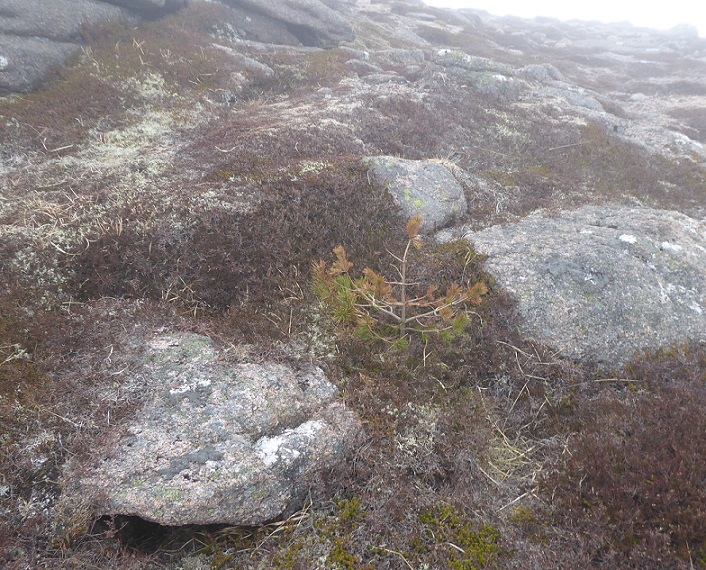
Even where seeds fall on suitable soils, they are so shallow that as the sapling grows it becomes increasingly vulnerable to desiccation. Most of the trees we saw higher up had brown needles, a consequence perhaps of the drought last Spring but a perennial challenge.
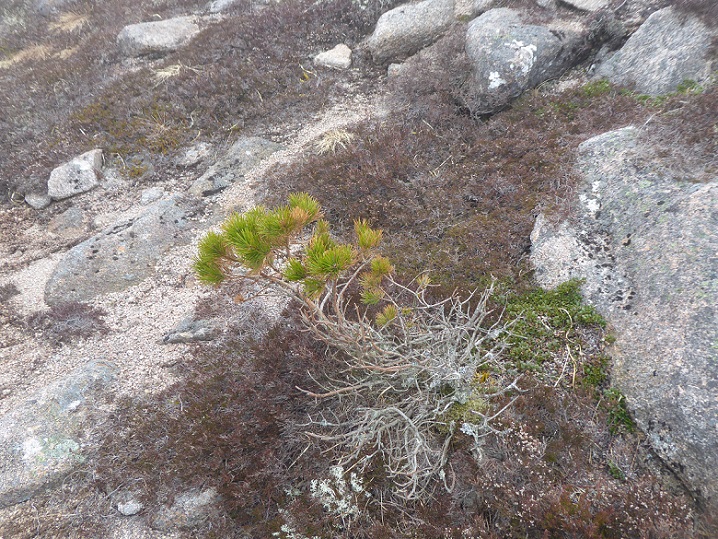
With fewer seeds germinating and their chance of survival lower in this harsh environment, those trees that have become established due to the dramatic reduction in deer density are nevertheless very likely to be grazed. All it takes is one unseasonal snow fall and for there to be one deer on the hill and these isolated pines become a target for grazing.
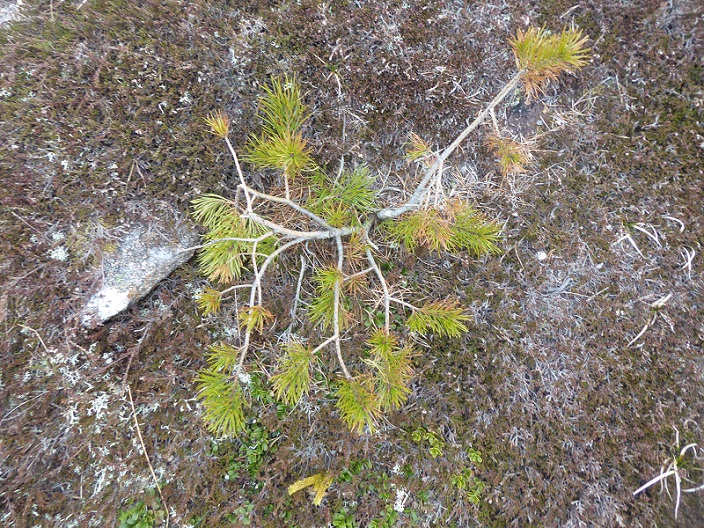
Trees, however, like many other types vegetation modify the natural environment around them. It is likely that as more become established high up in the Cairngorms the rate of natural regeneration will increase.
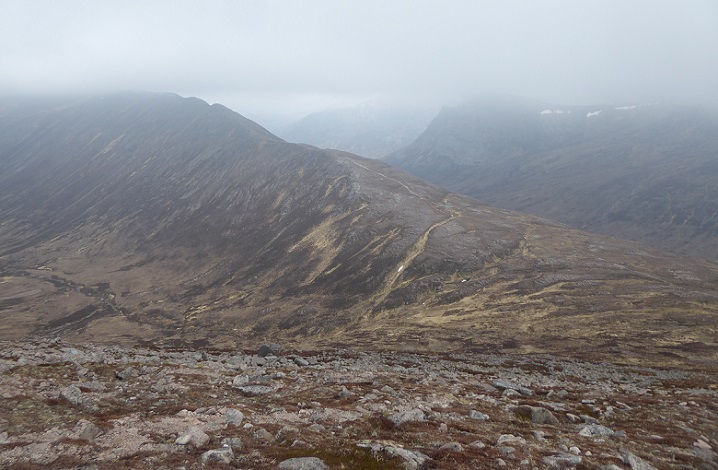
Walking from Carn Crom over Derry Cairngorm, Creag a Choire Etchachan and Ben MacDui we did not see another Scots Pine until we got down to the col with Carn a Mhaim which is close to 850m in altitude.
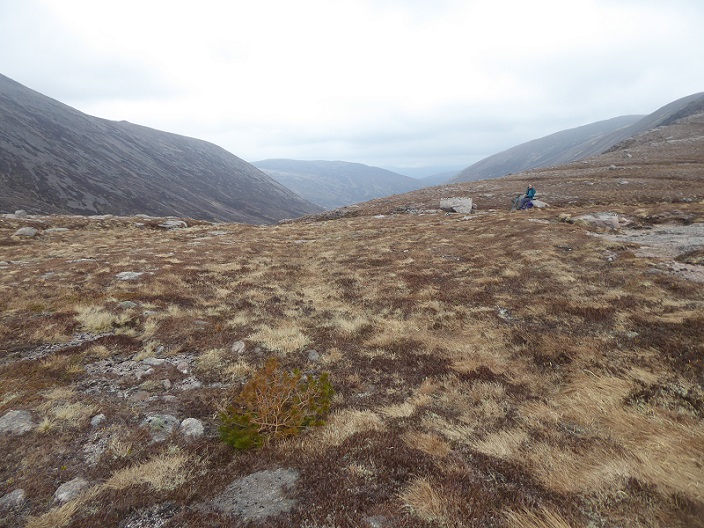
Sitting down for a bite on a rock, I spotted one pine, went over to have a look and found four more within a short distance. Like the Scots Pine high up on Carn Crom none of the pine looked in good condition, brown needles and browsing. But the question that interested me was how had they got here? The nearest obvious seed source would be the regenerating woodland in Glen Lui, four kilometres away to the south east:

If some or all of the seed from which these trees originated came from Glen Lui, it was carried obliquely to prevailing wind, was blown several hundred metres up hill, swept round a bend in the glen and somehow avoided becoming trapped in any of the vegetation on the way. If that is possible it is also possible that the seed got carried over on the prevailing wind from Glen Feshie. Or alternatively, perhaps there is a lone pine somewhere on the crags around the Lairig Ghru that provided the seed. Perhaps genetic tests could provide the answer?
Wherever the seed source, the evidence from Mar Lodge (and Wild Land Ltd) shows when deer density reduces to two per square kilometre or less, trees start popping up all over the place. For each of the pine on the col between Cairn a Mhaim and MacDui, hundreds if not thousands of other seeds will have been blown over this landscape or carried by birds and animals in the recent past. That is happening all over Scotland and for many species of tree but most people never appreciate the fact because most trees get eaten as soon as they protrude above the surrounding vegetation and are never seen by a human.
The claim commonly used by the forestry industry to justify planting trees, that there is no seed source, is in my view mostly a myth. Our public agencies have become so accustomed to the unnaturally high levels of deer in Scotland that they can no longer see what is obvious in most other European countries, where deer numbers can often be as low as 0.5 per square kilometre. Trees and other plants will regenerate naturally, without any need for damaging planting, so long as grazing pressure is properly controlled.
Sadly, neither NatureScot nor either of our two National Park Authorities recognise the fact that deer densities in Scotland are still far too high compared to our continental counterparts, nor have they acted on the evidence that has emerged in areas within Scotland where deer densities have been dramatically reduced. Shaila Rao’s excellent paper was written 7 years ago now and still nothing has changed.
Moreover, by adopting the 10 per sq km benchmark referred to in the report of the Deer Working group as the upper limit for deer on the open hill these agencies have actually compounded the problem and in the case of SNH are now far less progressive than they were 28 years ago when Mar Lodge was purchased.
I will demonstrate in my next post how the 10 deer per sq km is making it much more difficult for conservation owners to achieve their objectives and shunting costs onto them.

This is actually a very interesting and useful post.
To get natural regeneration, you obviously do need to have a seed source SOMEWHERE.
90% + of seed will fall within 50-100 metres from seed sources, and you can see that very clearly at Mar Lodge.
However, some seed will travel MUCH further, either on the wind, or across snow. It is well understood that if Scots Pine seed falls on to a frozen snow surface, then the wind can push it along for very significant distances indeed, until the snow starts to melt a bit, at which point the seed will settle. This is why you often get clusters of seedlings in the same approx area, with very little elsewhere, the combination of winds and contours taking seed to the same general area. A different wind on a different day might take them somewhere else. The right combination of frozen snow and wind probably does’nt happen that often, but often enough to make an impact in landscape after 20 years.
Two other observations.
One is that trees can grow better at higher altitudes if there are other trees around them. ie density is important. There is more safety in numbers against deer, and also mutual shelter.
The second is that the single most important herbivore of Scots Pine seedlings in Scotland is not actually deer, but slugs, which can destroy up to 90% of seedlings. What this means in practice is that whatever density of seedlings you want, you need to produce 10 X that amount to allow for this one source of loss alone. Wind. drought, flooding, fungal diseases…. all can kill a huge % of seedlings, and all that BEFORE you even begin to consider deer. Ultimately, this is why a pine tree produces millions of seeds over a lifetime, because 99.99% of them will die and there is nothing that can be done about those. Deer control helps the 0,01%.
There will be a VERY useful exercise for someone in the near future, looking at pinewood regeneration on Mar Lodge, and trying to work out where specific clusters of trees came from. That would improve understanding for everyone. It is the 10% of the 0.01% that is the most interesting, and which we should try better to understand.
Hi Victor, I agree with most of this and with warmer winters/less snow its possible that the ability of pine seeds to be blown great distances reduces. You make no mention, however, of the role of birds and animals in dispersing seed – crucial for species like oak and rowan. Instead of Scottish Forestry forking out grants on the basis there is no need source, it would be very interesting if for a few areas where foresters were claiming there was no seed source, Scottish Forestry paid a landowner who could be trusted to do so to reduce deer to under 2 per square km for ten years on an area where trees might get established (ie not on deep peat bog) and see what happened. Your statement that “Deer control helps the 0.01%” taken in isolation is highly misleading. It is the 0.01% of pine seeds that get established, having survived all the other factors you describe, that are crucial if trees are regenerate and when those trees get eaten by deer woodland effectively dies out.
Victor’s point abut the distance that seed can blow is right. There is a snow situation where the surface layer freezes forming a semi-hard cap. When you look at what is happening then you see a dusting of particles, sometimes quite dense, blowing over that frozen surface and, watching the speed at which this happens, you realise it could be over the hill and in the next glen in hours. If you look there are tree seeds among them. Sitka is very good at spreading this way. At the tops of the high ridges in Glen Buchat for example, you will find young sitka and can look far down the hill to see the distant but nearest source of seed. I am always surprised not to see some birch among the regenerating pine as they also seed prolifically.
One thing about trees on Mar Lodge estate that has always intrigued me is the whitebeam in the Quoich gorge which I don’t think NTS has ever investigated – but I may be wrong. I once found a single free standing whitebeam in Glen Quoich when I was rather young and could not identify it properly but could not find it later.
Spot on as usual Nick. The hearts and minds of NS and deer managers need to accept the change to 2 deer per km2. How can we achieve this?
Hi Hugh, sorry for late reply. I think the first and most important thing we can do is establish better understanding by both the public and politicians that deer numbers are far too high and I think the simplest way to do this is promote 2 deer per sq km is the starting point and the current benchmark of ten a disaster. We just need to keep repeating 2 and showing the evidence for this. Nick
I defer to greater knowledge of the whole area re regeneration.
A few thoughts though.
Professor Richard Oram have a lecture in kingussie a couple of years ago about the importance of pigs in 13th century Badenoch recognizing the importance of the animals’disturbance and consequently preparation of a seedbed for trees.
In Feshie I’m not seeing a great deal of regen SE of Badan Mosach on ground with a closed heather covering.
I was up Glen Tromie yesterday on Wildlands territory and at Brahan cottage noticed bags of tree seedlings. I guessed about 10 000 pines and much smaller numbers of alder and willow
Hi Dick, I am not arguing there should be no deer. In terms of animal disturbance helping trees to get established that applies on some ground/types of vegetation not others. Grazing and trampling high up on the hill, where there is little to eat, is likely to finish off any trees that do get established, hence the lack of a montane scrub zone in Scotland. I have just come back, however, from Loch Arkaig where I walked through the Allt Mhuic butterfly reserve where cattle are being used to help the woodland – saplings and cattle dung everywhere, best example I have seen of livestock to promote natural regeneration. As for Wildland Ltd, not only does their evidence show there is no need to plant the Tromie, if they have not planted the saplings now that is going to be another failed tree planting as its too late in year to do so. Very disappointing.